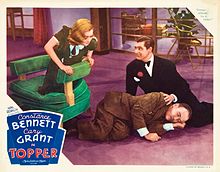
James Thorne Smith, Jr. was an American writer of humorous supernatural fantasy fiction under the byline Thorne Smith. He is best known today for the two Topper novels, comic fantasy fiction involving sex, much drinking and ghosts. With racy illustrations, these sold millions of copies in the 1930s and were equally popular in paperbacks of the 1950s.

Constance Campbell Bennett was an American stage, film, radio, and television actress and producer. She was a major Hollywood star during the 1920s and 1930s; during the early 1930s, she was the highest-paid actress in Hollywood. Bennett frequently played society women, focusing on melodramas in the early 1930s and then taking more comedic roles in the late 1930s and 1940s. She is best remembered for her leading roles in What Price Hollywood? (1932), Bed of Roses (1933), Topper (1937), Topper Takes a Trip (1938), and had a prominent supporting role in Greta Garbo's last film, Two-Faced Woman (1941).

Roland Young was an English-born actor. He began his acting career on the London stage, but later found success in America and received an Academy Award nomination for his role in the film Topper (1937).

Merrily We Live is a 1938 American comedy film directed by Norman Z. McLeod and written by Eddie Moran and Jack Jevne. It stars Constance Bennett and Brian Aherne and features Ann Dvorak, Bonita Granville, Billie Burke, Tom Brown, Alan Mowbray, Clarence Kolb, and Patsy Kelly. The film was produced by Hal Roach for Hal Roach Studios, and was distributed by Metro-Goldwyn-Mayer.
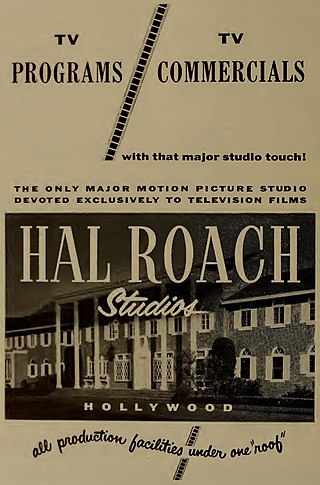
Hal Roach Studios was an American motion picture and television production studio. Known as The Laugh Factory to the World, it was founded by producer Hal Roach and business partners Dan Linthicum and I.H. Nance as the Rolin Film Company on July 23, 1914. The studio lot, at 8822 Washington Boulevard in Culver City, California, United States, was built in 1920, at which time Rolin was renamed to Hal E. Roach Studios. The first series in Hal Roach Studios were the Willie Work comedies, with first short being A Duke For A Day.

Topper is an American fantasy sitcom television series based on the 1937 film Topper, which was based on two novels Topper and Topper Takes a Trip by Thorne Smith. The series was broadcast on CBS from October 9, 1953, to July 15, 1955, and stars Leo G. Carroll in the title role. It finished at #24 in the Nielsen ratings for the 1954–1955 season. Topper also earned an Emmy nomination for Best Situation Comedy in 1954.

Zenobia is a 1939 comedy film directed by Gordon Douglas and starring Oliver Hardy, Harry Langdon, Billie Burke, Alice Brady, James Ellison, Jean Parker, June Lang, Stepin Fetchit and Hattie McDaniel. The source of the film was the 1891 short story "Zenobia's Infidelity" by H.C. Bunner, which was originally purchased by producer Hal Roach as a vehicle for Roland Young.
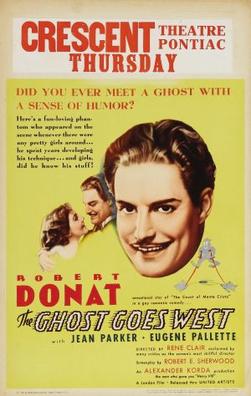
The Ghost Goes West is a 1935 British romantic comedy/fantasy film starring Robert Donat, Jean Parker, and Eugene Pallette, and directed by René Clair, his first English-language film. The film shows an Old World ghost dealing with American materialism.

Robert Sterling was an American actor. He was best known for starring in the television series Topper (1953–1955).

The Phantom President is a 1932 American pre-Code musical comedy and political satire film. It was directed by Norman Taurog, starred George M. Cohan, Claudette Colbert, and Jimmy Durante, with songs by Richard Rodgers (music) and Lorenz Hart (lyrics).
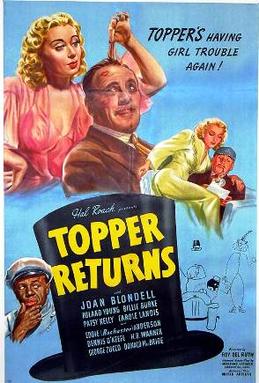
Topper Returns is a 1941 American supernatural comedy thriller film directed by Roy Del Ruth and written by Jonathan Latimer. The third and final installment in the initial series of supernatural comedy films inspired by the novels of Thorne Smith, it succeeds Topper (1937) and Topper Takes a Trip (1938).

Topper Takes a Trip is a 1938 supernatural film directed by Norman Z. McLeod. It is a sequel to the 1937 film Topper. Constance Bennett, Roland Young, Billie Burke, and Alan Mowbray reprised their roles from the earlier film; only Cary Grant was missing. A ghost tries to reunite a couple who she had a hand in splitting up in the prior film. It was followed by another sequel, Topper Returns (1941). The movie is in the public domain.

Rockabye is a 1932 American pre-Code drama film starring Constance Bennett, Joel McCrea, and Paul Lukas. The final version was directed by George Cukor after studio executives decided that the original film as directed by George Fitzmaurice was unreleasable. The screenplay by Jane Murfin is based on an unpublished play written by Lucia Bronder, based on her original short story.

Let's Go Native is a 1930 American pre-Code black-and-white musical comedy film, directed by Leo McCarey and released by Paramount Pictures.

Wild Horse Mesa is a 1925 American silent Western film directed by George B. Seitz and starring Jack Holt, Noah Beery Sr., Billie Dove, and Douglas Fairbanks Jr. Based on the novel Wild Horse Mesa by Zane Grey, the film is about a rancher who, desperate for money, decides to trap and sell wild horses using barbed wire. The local Navajo tribe tries to persuade him not to do it. The film was produced by Famous Players–Lasky and released by Paramount Pictures. Wild Horse Mesa was filmed on location in Colorado. Prints of the film have survived.

Jean Harlow was an American actress who made her uncredited debut in two 1928 films: Honor Bound for Fox Film; and Moran of the Marines for Paramount Pictures. While waiting for a friend at the studio in 1928, she was discovered by studio executives who gave her letters of introduction to casting agencies, where she was offered the two small roles that subsequently launched her film career. During the initial two years of her career, Harlow appeared uncredited in 16 films, including several Hal Roach productions developed for Laurel and Hardy. Her first speaking role was a bit part in the 1929 American pre-Code romantic comedy The Saturday Night Kid, starring Clara Bow and Jean Arthur. The film has since been preserved by the UCLA Film and Television Archive.
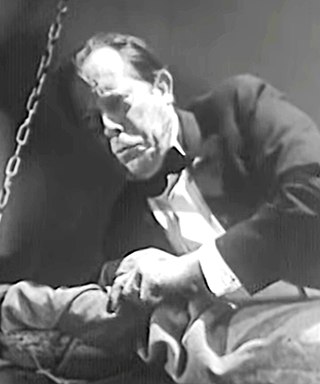
William Sidney Stanton was an English-born American character actor, whose career spanned the first 25 years of the sound films. Stanton broke into the film industry at the end of the silent film era in 1927, appearing in several film shorts for Hal Roach Studios. He appeared in 70 films, mostly in supporting roles.
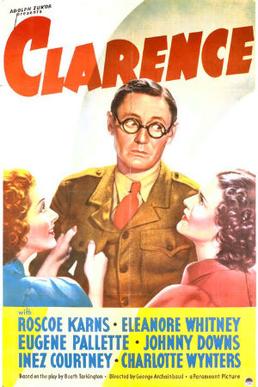
Clarence is a 1937 American comedy film directed by George Archainbaud and written by Grant Garett and Seena Owen. The film stars Roscoe Karns, Eleanore Whitney, Eugene Pallette, Johnny Downs, Inez Courtney and Charlotte Wynters. It is based on the play Clarence by Booth Tarkington. The film was released on February 12, 1937, by Paramount Pictures.

In Old Sacramento is a 1946 American Western film directed by Joseph Kane and written by Frances Hyland and Frank Gruber. The film stars Wild Bill Elliott, Constance Moore, Henry H. Daniels Jr., Ruth Donnelly, Eugene Pallette and Jack La Rue.

Hell's Hole is a lost 1923 American silent Western film directed by Emmett J. Flynn and written by Bernard McConville. The film stars Buck Jones, Maurice Bennett Flynn, Ruth Clifford, Eugene Pallette, George Siegmann, and Kathleen Key. The film was released on September 23, 1923, by Fox Film Corporation.








